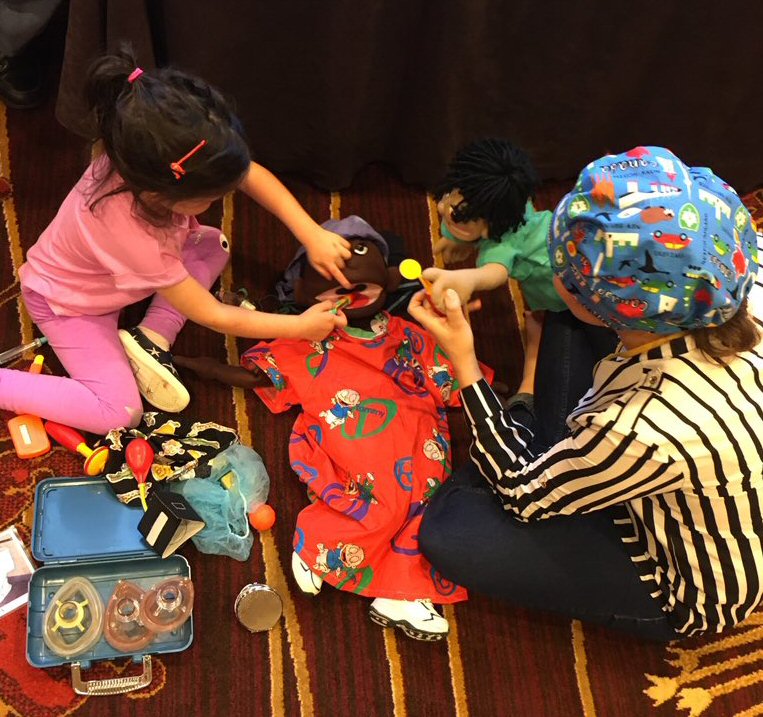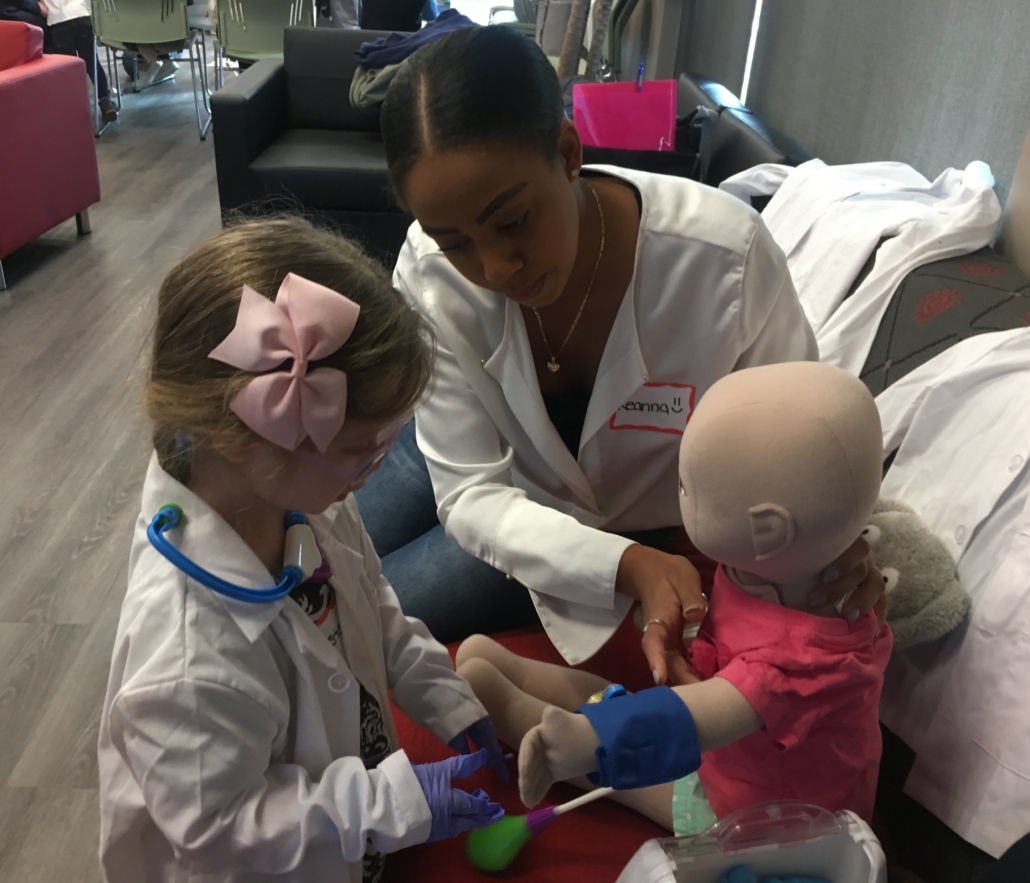Child Life Programs: Play With Purpose at Retinoblastoma Gatherings
Monday March 2, 2020
Eye cancer is a potentially overwhelming experience for young children, whether patient or sibling. Child life can radically improve care and life for the entire family, but too many children lack access to this specialist support. Abby White shares how WE C Hope supported Child Life programs are helping to change that.
When your life is turned upside down by the diagnosis of aggressive childhood eye cancer, meeting others who know and understand your journey is a priceless gift. In-person support specific to the needs of children, families and survivors affected by retinoblastoma is much needed, but very rare.
Retinoblastoma Family Days provide fun, friendship, knowledge and hope. Events organised in collaboration with medical programs often include educational talks, facilitated discussion groups, and collaborative workshops for parents, adolescent and adult survivors. The learning and shared experience creates stronger, more knowledgeable and confident healthcare advocates.
Family Days offer a wonderful opportunity to bring retinoblastoma specific child life support to diagnosed children and their siblings. Child life is internationally recognised as a vital component of medical care for seriously ill children, and child life support is embedded in paediatric oncology units throughout the developed world. However, most children with retinoblastoma receive the majority of their care in ophthalmology clinics, where child life has far less presence.
While parents and survivors meet to learn and share their experiences at Family Day events, children’s programing can offer highly specialist support tailored to the needs of its young patrons. Child Life sessions for retinoblastoma care can work equally well alongside a formal medical meeting or an adults get-together over coffee or mojitos. The key to effective programming is a child life specialist who has proven experience in caring for children and families affected by retinoblastoma, and understanding of the complex needs this diagnosis raises.
The following photographs were taken during retinoblastoma specific Child Life programs led by WE C Hope Child Life Director Morgan Livingstone, her interns and volunteers. Sessions were held alongside medical meetings and Family Days in Calgary, Toronto, and Washington D.C. between October 2017 and January 2020.
We are thankful to all the children, parents and child life team who have allowed us to share their photographs.
Eye Love Art
Children have a wide variety of art activities to learn with, all themed around the eyes. Programs have included collage posters, gift bag decoration, photo/video art, papier mache, and clay creations, in addition to the ever popular colouring station. Arts and crafts focused on the eyes open up opportunity for conversation with children about their experiences with retinoblastoma treatment, prosthetic eyes, sight, and the many impacts on their life.
Children create a giant mural together to celebrate the day.
Morgan and her child life volunteers are on hand to help very young children with their art projects, and nurture conversations they spark about the child’s Rb experience.
Eyeball gift bags, created by children during an EyeLoveArt project.
Superhero Masks
Children diagnosed with #retinoblastoma and their siblings experience far more in their early years than any child should be expected to endure. They are superheroes. They always have fun making their own superhero masks while sharing what makes each of them super!
Sensory Play
Sensory play includes activities that stimulate children’s senses through touch, smell, taste, movement, balance, sight and hearing. Fun, interactive sensory activities include making slime / putty, creating musical instruments using recycled materials, and a blindfolded tasting station to learn about how taste buds work (sour, sweet, bitter). All these activities naturally encourage children to be curious, explore and use scientific processes while they play, create, and investigate.
Children of all ages enjoy the bubble wrap slide, which encourages kids to explore different kinds of movement to cenerate the unique bubble wrap sounds, and attempt to pop the bubbles.
Many art and craft activities on offer are highly tactile. Clay and playdough are firm favourites.
Bubbles
Blowing bubbles promotes deep breathing that helps both body and mind relax. Children who learn to regulate their breathing cope better with potentially stressful medical procedures. That’s why bubble play is a big part of child life activities.
Children can choose from a wide range of wands at the popular bubble station. They can also create and capture bubbles by dipping an anaesthetic mask in a cap of bubble solution, and blowing through it. Turning the mask into something fun helps make it less scary and encourages children to practice the action of slow, deep breathing required for anaesthetic induction – a regular procedure for babies and children with retinoblastoma.
Morgan’s former Child Life intern, Kim, blows bubbles through an anaesthetic mask, while two young children dance around her, enjoying the effects. The bubble play helps the children feel confident to touch and play with the mask on their own terms later.
Cloth Dolls
Children are invited to design and create a doll/mascot of themselves. This doll can be used to personalize medical play, facilitate discussion, and practice upcoming procedures and assessments in clinic.
By observing children’s play with the cloth doll, Morgan and her child life team can identify specific concerns or misconceptions the child may have. They can then guide medical play to help strengthen the child’s understanding and coping skills.
Cloth Doll Decoration Station.
Medical Play with personalised cloth dolls.
Cloth dolls and self published books created by children during a child life session.
Co-Creating a Board Game
Depending on the program of the event and the age of participants at the child life program, children can co-create a group board game to play during family day activities. Co-creating means including positives and negatives about the children’s lives, family, friends and treatment experiences, to become part of the game.
A positive like “I did my homework without being asked” results in a free roll, or advancing a few spaces. A negatives like “I talked back to my mom when I was angry” results in a missed turn, or going back a few spaces. The group discuss and add tasks or actions for players to do if they land on certain spaces – like, sing a song or tell a joke. The game allows children to think and talk about the negatives and positives they feel are important.
When facilitated by a child life professional, co-creating a group board game can be a transformative activity for older children and siblings living with a complex medical diagnosis and the stress it generates.
This large floor board game was made from a table cloth.
Medical Play
Play is the language of children and youth, and medical play is a huge part of all Retinoblastoma Child Life programs. A wonderful exploration of common medical materials, where children can dress up in scrubs and “BE” the doctor, handle real and toy medical equipment, and carry out procedures on medical dolls. They can blow bubbles with sedation masks, and even get creative with syringe splatter paintings, and IV tubing bracelets.
Medical play allows children a safe and fun way to familiarize themselves with medical materials in a non-threatening way, to practice routine procedures, and gain mastery over their own medical experiences – all while having loads of fun with other kids who share their experiences.
Giving Eye Drops
Before Exams Under Anaesthetic and office eye exams, eye drops are administered to dilate a child’s pupils. Many children also have additional frequent eye drops as part of their retinoblastoma care. This seemingly innocuous procedure can cause children huge anxiety and distress that often escalates over time.
Child Life programs give children the opportunity to practice giving pretend eye drops to medical dolls and stuffed animals. The positive experience helps children minimize their anxiety. With new confidence and a sense of control over their fear, some older children even progress to putting water drops or artificial tears in their own eyes.
Elli was designed as a learning tool for children with retinoblastoma. Here, the child has removed Elli’s eye before giving the elephant pretend eye drops.
Mask Play and Surgery Preparation
Due to their young age, children with retinoblastoma must be anaesthetised to examine their eyes. During active treatment and close follow up care, Exams Under Anaesthetic (EUA) occur every 3-4 weeks. Many children have surgery to remove one or both eyes, to prevent the cancer spreading. They may also have surgery to insert or remove a central line or ommaya reservoir to deliver chemotherapy. Young children are also routinely anaesthetised for MRI scans and radiotherapy treatment.
The sedation mask causes many children great anxiety before and during anaesthetic induction, and their distress can linger when they wake in recovery. Preparing a child for the surgical experience greatly aids their well-being before, during and after the procedure.
Mask play familiarizes children with anaesthetic induction, and equipment used in the procedure. They learn the mask does not hurt, and master the different steps of the process, giving him more confidence and reducing anxiety.
Preparation varies for different age groups. Mask play during retinoblastoma child life programs gives children of all ages ample opportunity to prepare well for anaesthesia induction in a relaxed, fun environment.
By exploring the mask on her own terms – squeazing, biting, and chewing – this little girl develops confidence to use it as intended, holding it up to her mouth ready to practice deep breaths.
Learning About Enucleation and Prosthetic Eyes
Many children with retinoblastoma have an eye removed to save their life. Though a simple surgery in most cases, this is a complex experience for the child and family. Preparing children for this surgery, and normalising prosthetic eyes, is vital for their complete wellbeing.
Kamau is a medical play puppet, custom-made for Morgan’s work with children affected by retinoblastoma. His removable eye enables children to learn about the surgery and handling a prosthetic eye through play. His eyelids were designed to resemble the “pockets” of the human eyelid, so children can explore the realistic process of removing and replacing the prosthetic eye in a non-threatening way.
Self-Published Books
This exciting and engaging transformative literacy activity encourages children and youth to create a narrative book about all the things that make them an amazing individual. With some guiding statements like “I am….” and “I can…”, children are able to share their thoughts, feelings and experiences in narrative form. Their personality shines through as they illustrate their book with drawing, collage and scrapbook art materials.
We also encourage parents to write their own personal story, highlighting what they admire most about their amazing children, sharing their hopes and wishes for their child’s future.
Children can choose from a wide range of expressive materials as they write and illustrate their book.
Patients, survivors and siblings are pictured here working on their self published books.
Supporting More Children
We will continue providing child life programs at meetings of One Retinoblastoma World Meetings, the Canadian Retinoblastoma Research Advisory Group, and similar meetings. We hope to expand child life sessions to social Family Gatherings to reach more children, particularly as we develop family support activities across the USA.
If you would like to help give kids this opportunity to cope better with their medical care, please donate to WE C Hope – your gift makes our work possible. Thank you so much!
Child Life at One Rb World 2024 in Hawaii
Psychological support for children and their families is a vital part of retinoblastoma care, from before diagnosis through treatment and beyond. Integrating these supports into Rb care is a global challenge, but as previous One Rb World meetings show, opportunities exist to enhance child-centred care in all regions of the world.
National and global collaboration between retinoblastoma specialists, researchers, parents, survivors, and other advocates can dramatically improve the psychological experience and medical outcomes for each child with eye cancer, their family and the survivor decades beyond treatment.
If you would like to join this global community sharing knowledge and experience, learning from one another, and exploring priority subjects together, we welcome you to the 7th One Rb World meeting, October 15-17 2024 in Honolulu, Hawaii. The meeting will be held just before the International Society of Paediatric Oncology World Congress which takes place 17-20 October, 2024 at the Honolulu Convention Centre.
One Rb World is community, conversation, and cooperation. An inclusive global collaboration for optimal lifelong care. Children are welcome too – One Rb World is proud to offer a fun program for Rb patients, young survivors, siblings, and children of adult survivors, fully staffed by child life professionals familiar with Rb care! Activities are tailored specifically to our young retinoblastoma community, mindful of the medical and life experiences they may encounter.
About the Author
Abby’s father was diagnosed with bilateral retinoblastoma in Kenya in 1946. Abby was also born with cancer in both eyes. She has an artificial eye and limited vision in her left eye that is now failing due to late effects of radiotherapy in infancy.
Abby studied geography at university, with emphasis on development in sub-Saharan Africa. She co-founded WE C Hope with Brenda Gallie, responding to the needs of one child and the desire to help many in developing countries. After receiving many requests for help from American families and adult survivors, she co-founded the US chapter to bring hope and encourage action across the country.
Abby enjoys listening to audio books, creative writing, open water swimming and long country walks.


































How do we know when the next RB event will be?
Hi Torri, we’ve added a new Rb Community Events section to our website’s Rb Resource today, which will list upcoming events. You can find it at https://wechope.org/rbevents/ or at the top of the Find Hope menu.